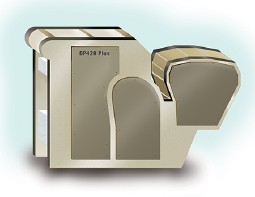File Prep – A Simple Overview
To help provide a smooth path for your projects, we have compiled an overview of every tech tip and trick we can think of to ensure your artwork file meets our requirements before you place your order. We're on your side, so we strongly recommend you take a couple of minutes to review this checklist. Our goal is to help you create a perfect, trouble-free file.
Color Accuracy
We require all submitted graphic design files to be saved in CMYK to ensure color accuracy. RGB files that are submitted will be converted to CMYK (it is our preference that you convert your RGB files to CMYK before submitting).
Font and Text Tips
If you are working in a vector-based software like InDesign, Quark, or Illustrator, all text must be converted to outlines before generating the final .pdf file. If you are working out of Photoshop, simply flatten the image. We strongly suggest that you do not use any fonts smaller than 7 pt. Here's a cool visual depicting various text sizes.
Resolution
For an image to print properly, its resolution must be at least 300 dots per inch (DPI) at the final output size. Files with higher resolutions are accepted, but not necessary, as it will not improve the printed quality of your project.
File Size
All of your design files need to be built to the final cut-trim size, plus bleed allowance. That means your file should be 1/4" larger than the actual finished size of the project you are designing. (Example: A 4x6 postcard should be built as a 4 1/4 x 6 1/4 graphic file.)
Crop Marks
We ask that your files be saved without any crop marks, as they will be considered a part of the artwork and will be printed otherwise.
Safety Zone
We strongly suggest that your designs do not place any text or images in the safety zone — an imaginary space 1/8" from the final trim size. Text or content in the safety zone is often cut off when your printed document is trimmed.
Line Width
Ok, here's an easy one to overlook. We strongly suggest setting your line thinkness to at least 0.25 points or 0.003 inches. A one or two-point line is very popular and looks especially good around photographs. Here's a graphic showing various line widths and how they appear on the page.
Compression
When preparing to send files to us through the website, we suggest you compress your files first. Compressing files allows you to combine multiple files into one compressed archive file, which will often upload to us much faster, saving you time. Read more about file compression in our FAQs.
Typos and Grammar
We always suggest taking a second look to proofread the document you are about to print. We assume no responsibility for typographical errors or grammatical mistakes.
Acceptable File Formats
- Adobe Acrobat - .PDF
- Adobe Illustrator - .AI
- Adobe InDesign - .INDD
- Adobe Photoshop - .PSD
- Bitmap File Format - .BMP
- Corel Draw - .CDR
- EPS - .EPS
- Joint Photographic Experts Group File Format - .JPEG
- Microsoft PowerPoint - .PPT
- Microsoft Publisher - .PUB
- Microsoft Word - .DOC
- QuarkXpress - .QXD
- Tagged Image - .TIF


